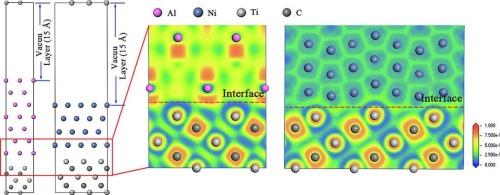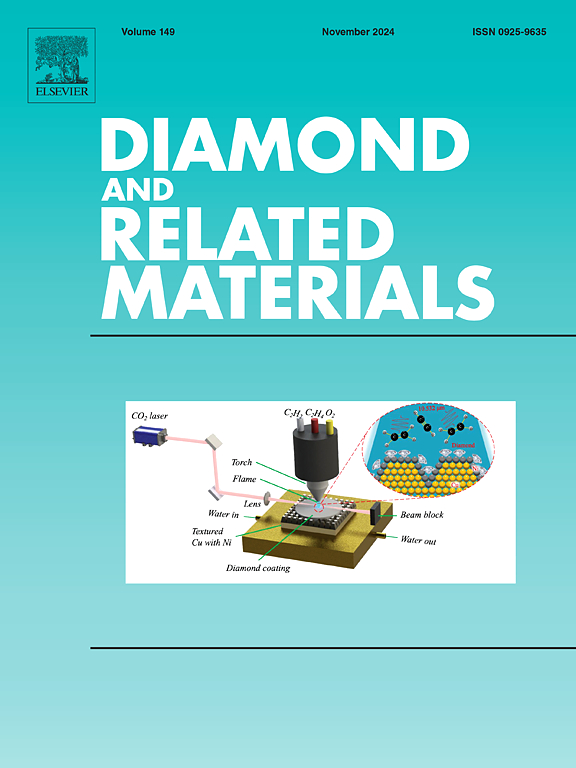增强铝基复合材料上镍涂层 Ti3C2 MXene 的界面性能:第一原理研究
IF 4.3
3区 材料科学
Q2 MATERIALS SCIENCE, COATINGS & FILMS
引用次数: 0
摘要
Ti3C2 MXene 作为铝基复合材料的增强相可能具有深远的前景。在 Ti3C2 表面镀镍是改善 Al-Ti3C2 界面润湿性、提高 Ti3C2 与铝基体结合强度的重要方法。本文通过第一性原理计算研究了 Al/Ti3C2 与 Ni/Ti3C2 界面的界面关系,并比较了 Al(111) 与 Ni(111) 和 Ti3C2(001) 之间的差异。首先,通过晶格失配理论构建了 Al(111)/Ti3C2(001) 和 Ni(111)/Ti3C2(001) 的界面结构。然后,计算了两种界面结构的附着功和界面能。结果表明,Al(111)/Ti3C2(001) 的附着功和界面能分别为 2.5 J/m2 和 - 0.15 J/m2,而 Ni(111)/Ti3C2(001) 的附着功和界面能分别为 4.03 J/m2 和 0.77 J/m2。最后,分析并讨论了 Al(111)/Ti3C2(001) 和 Ni(111)/Ti3C2(001) 界面的电子特性。结果表明,Al(111)/Ti3C2(001) 的主要成键类型是金属键,而 Ni(111)/Ti3C2(001) 的主要成键类型是离子键和金属键。通过从理论计算的角度分析 Ti3C2 MXene 表面镀镍后与铝的界面性质,该研究为分析镍镀 Ti3C2 对铝基体复合材料界面结构的改善提供了理论支持。本文章由计算机程序翻译,如有差异,请以英文原文为准。

Enhanced interfacial properties of Ni-coated Ti3C2 MXene on Al-matrix composites: A first-principles investigation
Ti3C2 MXene may have a far-reaching prospect as a reinforcing phase for Al-matrix composites. Coating Ni on the Ti3C2 surface is an important method to improve the wettability of the Al-Ti3C2 interface and to enhance the bonding strength between Ti3C2 and the Al matrix. In this paper, the interfacial relationships of Al/Ti3C2 and Ni/Ti3C2 interfaces are investigated by means of first-principles calculations, and the differences between Al(111) and Ni(111) and Ti3C2(001) are compared. Firstly, the Al(111)/Ti3C2(001) and Ni(111)/Ti3C2(001) interface structures are constructed by lattice mismatch theory. Then, the adhesion work and interface energy of the two interfacial structures are calculated. The results show that the adhesion work and interface energy of Al(111)/Ti3C2(001) are 2.5 J/m2 and − 0.15 J/m2, respectively, and those of Ni(111)/Ti3C2(001) are 4.03 J/m2 and 0.77 J/m2, respectively. Finally, the electronic properties of the Al(111)/Ti3C2(001) and Ni(111)/Ti3C2(001) interfaces are analyzed and discussed. The results indicate that the main bonding type of Al(111)/Ti3C2(001) is metallic bonding, while that of Ni(111)/Ti3C2(001) is ionic and metallic bonding. By analyzing the interfacial properties of Ti3C2 MXene with Al after Ni coating on its surface from the perspective of theoretical calculations, this work provides theoretical support for analyzing the improvement of interfacial structure of Al-matrix composites by Ni-coated Ti3C2.
求助全文
通过发布文献求助,成功后即可免费获取论文全文。
去求助
来源期刊

Diamond and Related Materials
工程技术-材料科学:综合
CiteScore
6.00
自引率
14.60%
发文量
702
审稿时长
2.1 months
期刊介绍:
DRM is a leading international journal that publishes new fundamental and applied research on all forms of diamond, the integration of diamond with other advanced materials and development of technologies exploiting diamond. The synthesis, characterization and processing of single crystal diamond, polycrystalline films, nanodiamond powders and heterostructures with other advanced materials are encouraged topics for technical and review articles. In addition to diamond, the journal publishes manuscripts on the synthesis, characterization and application of other related materials including diamond-like carbons, carbon nanotubes, graphene, and boron and carbon nitrides. Articles are sought on the chemical functionalization of diamond and related materials as well as their use in electrochemistry, energy storage and conversion, chemical and biological sensing, imaging, thermal management, photonic and quantum applications, electron emission and electronic devices.
The International Conference on Diamond and Carbon Materials has evolved into the largest and most well attended forum in the field of diamond, providing a forum to showcase the latest results in the science and technology of diamond and other carbon materials such as carbon nanotubes, graphene, and diamond-like carbon. Run annually in association with Diamond and Related Materials the conference provides junior and established researchers the opportunity to exchange the latest results ranging from fundamental physical and chemical concepts to applied research focusing on the next generation carbon-based devices.
 求助内容:
求助内容: 应助结果提醒方式:
应助结果提醒方式:


